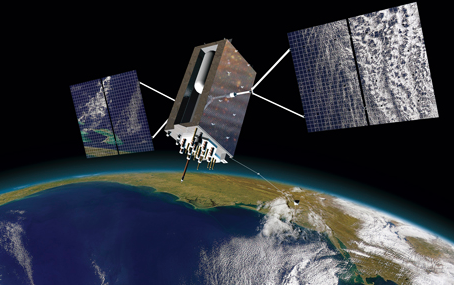
GPS III Most of the GPS satellites now on orbit have surpassed their operational design life and users are demanding more advanced capabilities. To sustain and modernize the constellation, the US Air Force and Lockheed Martin are developing the next generation satellite system, known as GPS III. GPS III will improve position, navigation and timing services and provide advanced anti-jam capabilities yielding superior system security, accuracy and reliability.
The Air Force is planning to send off an Evolved Expendable Launch Vehicle (EELV) Launch Service that supports the Global Positioning System (GPS) III-3 mission scheduled to launch in 2019. Rolling out the preparations begins with a Request for Proposal. The draft RFP was released on June 14 to obtain industry feedback to inform the Final RFP. The Final RFP was released on August 3 with proposals for an Evolved Expendable Launch Vehicle (EELV) due back to the Air Force no later than September 19 in accordance with the solicitation instructions.
Then the Air Force evaluates the proposals through a competitive, best-value source selection process, and they will then award a firm-fixed price contract that will provide the government with a total launch solution including;
- launch vehicle production
- mission integration
- launch operations for the GPS III-3 satellite
The Air Force's acquisition strategy for this solicitation achieves a balance between mission success/operational needs, and lowering launch costs, through reintroducing competition for National Security Space missions.
Lt. Gen. Samuel Greaves, Space and Missile Systems Center commander and Air Force program executive officer for Space said, "Launch system certification is a key element (high technical bar) within this solicitation to provide insight into the technical capabilities and rigorous processes that demonstrate a launch vehicle contractor's ability to design, develop, manufacture, and launch National Security Space missions and contributes to the overall flight worthiness process." Prior to contract award, the contracting officer will verify that the Offeror has a certified launch system as part of a responsibility determination resulting technical bar.
"Through this competitive solicitation for GPS III launch services, we hope to continue fostering competition in order to promote innovation and reduce cost to the taxpayer while maintaining our laser focus on mission success," Greaves stated.
This will be a standalone contract for one GPS III launch. GPS III is the next generation of GPS satellites that will introduce new capabilities to
meet the higher demands of both military and civilian users.
GPS III is expected to provide improved anti-jamming capabilities as well as improved accuracy for precision, navigation, and timing. It will
incorporate the common L1C signal which is compatible with the European Space Agency's Galileo global navigation satellite system and compliment current services with the addition of new civil and military signals. This is the second competitive launch service solicitation under the current Phase 1A procurement strategy. The Phase 1A procurement strategy reintroduces competition for National Security Space launch services. Under the previous Phase 1 strategy, United Launch Alliance (ULA) was the only certified launch provider. In 2013, ULA was awarded a sole-source contract for launch services as part of an Air Force "Block Buy" of 36 rocket cores that resulted in significant savings for the government through FY 2017.
In May 2015, Space Exploration Technologies (SpaceX) was certified for EELV launches resulting in two launch service providers that are qualified to design, produce, qualify, and deliver a launch capability and provide the mission assurance support required to deliver National Security Space satellites to orbit.
The Air Force Space Command's Space and Missile Systems Center, located at the Los Angeles Air Force Base, Calif., is the U.S. Air Force's center of excellence for acquiring and developing military space systems. Its portfolio includes the Global Positioning System, military satellite
communications, defense meteorological satellites, space launch and range systems, satellite control networks, space based infrared systems, and space situational awareness capabilities. http://www.lockheedmartin.com/us/products/gps.html

